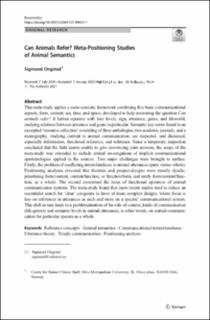| dc.description.abstract | This meta-study applies a socio-semiotic framework combining five basic communicational aspects, form, content, act, time, and space, developed to help answering the question Can animals refer? It further operates with four levels, sign, utterance, genre, and lifeworld, studying relations between utterance and genre in particular. Semantic key terms found in an excerpted ‘resource collection’ consisting of three anthologies, two academic journals, and a monography, studying content in animal communication, are inspected, and discussed, especially information, functional reference, and reference. Since a temporary inspection concluded that the field seems unable to give convincing joint answers, the scope of the meta-study was extended to include critical investigations of implicit communicational epistemologies applied in the sources. Two major challenges were brought to surface. Firstly, the problem of conflicting interrelatedness in animal utterances (parts versus whole). Positioning analyses revealed that theories and project-designs were mostly dyadic, prioritising form/content, content/function, or function/form, and rarely form/content/func- tion, as a whole. The second concerned the issue of functional openness of animal communication systems. The meta-study found that more recent studies tend to reduce an essentialist search for ‘clear’ categories in favor of more complex designs, where focus is less on references in utterances as such and more on a species’ communicational system. This shift in turn leads to a problematisation of the role of context, kinds of communication (life-genres) and semantic levels in animal utterances, in other words, on animal communi- cation for particular species as a whole. | en_US |

